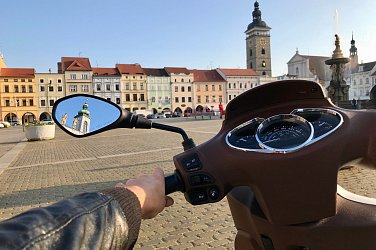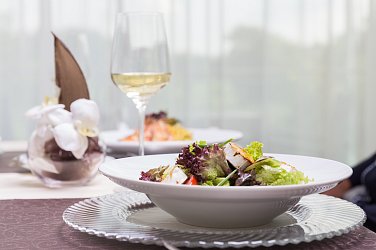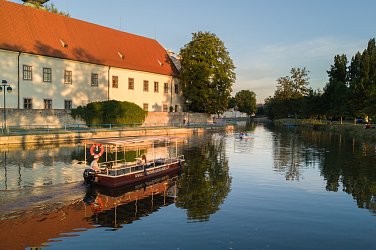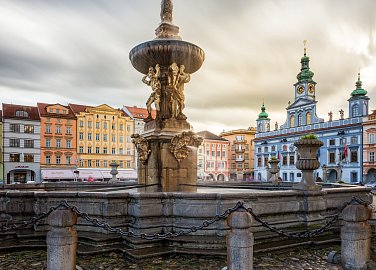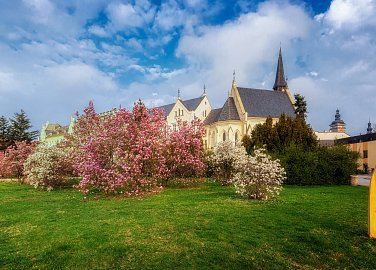Walking Routes - Historical centre
The route: Přemysl Otakar II Square - St. Nicholas Church - Black Tower - Wortner House - Hradební Street - Na Sadech Park - Holy Family Church - South Bohemian Museum - Kněžská Street - St. Anna Church - Charles IV Street
Přemysl Otakar II Square has always been the natural centre of the city. With its almost square ground plan of 132×137 metres, which was brilliantly measured by the knight and burgrave of the royal castle Zvíkov, Hirzo , it is one of the largest in the country. After the city was founded in 1265, the square mainly served as a marketplace; later it witnessed all important events of the city. There are 48 historical houses along its perimeter, the most important of which is the town hall. Its emblematic appearance had to reflect the importance of the city. The present-day Baroque appearance of the historical building dates back to 1727–1730 and was designed by Antonio Erhart Martinelli. The monumental façade is enhanced by three towers, of which the middle, the tallest one, has been equipped with chimes since 1995. The four allegorical statues in the attic of the town hall represent the civic virtues - Justice, Bravery, Wisdom and Caution. Inside, the most luxurious room is the ceremonial hall where the vaulted ceiling is decorated with a fresco from 1730 depicting the biblical Judgement of Solomon. In the middle of the square there is also one of the symbols of the city, the Baroque Samson Fountain. It was built between 1721 and 1726 by stonemason Zachariáš Horn; the sculptural decoration was created by Josef Dietrich. At the top of the fountain, which is one of the largest in Bohemia, there is a statue of biblical Samson struggling with a lion. Not far from the fountain towards Zvon Hotel is the so-called Wandering Stone, marked by a cross. According to legend, there was a place of execution there; today it is associated with the superstition that anyone who crosses it between ten o'clock in the evening and the morning will find a way home.
From the square we head to the Cathedral Church of St. Nicholas, originally a Gothic building from the 13th century. In July 1641, however, it suffered a devastating fire: hence, its current appearance is Baroque. At the front of the church there are three statues - St. Wenceslas, St. Nicholas and St. Auracian , who is also the patron saint of the city . With the establishment of the bishopric of České Budějovice in 1785, the Church of St. Nicholas became a cathedral. During the 18th and 19th centuries the equipment was changed or repaired several times, which gradually led to the interior being simplified. At present, its most important part remains the main altar from 1791 with an older painting of St. Nicholas, a Rococo pulpit originally from the Kajetán church in Malá Strana in Prague and the Baroque altar of St. Anne and Virgin Mary from the 18th century in the side chapels. Until 1784, the town cemetery stood around the church.
Next to the church there is another dominant feature of the city, the 72 m- high Black Tower. Its construction between 1550 and 1577 was to express the economic boom of Renaissance České Budějovice, but at the same time it served as a bell tower and a watchtower: the city was constantly guarded against the danger of fire from the tower's gallery. Under the leadership of Italian builders Hans Spatz and Lorenz and Vincenc Vogarelli, the tower grew to a dizzying height of 72.25 metres. It is currently one of the most frequented tourist destinations, as it offers a beautiful view from the gallery, 46 metres above the ground. Just below the Black Tower, in a small area in front of the cathedral, stands a monument to Bishop Jan Valerian Jirsík. It was placed out of gratitude for tireless work especially for the local Czech education system. The monument is the last major work of Josef Václav Myslbek .
If you continue along U Černé věže Street, you will reach the Gothic-Renaissance Wortner House with a beautiful attic. Today, the Aleš South Bohemian Gallery where art exhibitions and art lectures are held is located here.
Before the last house at the end of the street, turn right into the narrow Hradební Alley , which runs along the former city walls. However, these are no longer visible.
At the intersection of Hradební and Kněžská Streets, turn left and, across the bridge, you reach a quiet green zone, Na Sadech Park. Along the way you can stop by the statue of the city’s founder, King Přemysl Otakar II. or the prominent Budejovice native, shipbuilder, builder and entrepreneur Vojtěch Adalbert Lanna (1805-1866), who is sometimes also known as the “Father of Czech transport” and who at the time was fundamentally responsible for the economic prosperity of the city.
Then you can go along the so-called Mlýnská stoka (Mill Canal) which will lead you to the Church of the Holy Family, which was declared a cultural monument in 2018. It was built between in 1886 and 1888 in the neo-Gothic style under the leadership of the builder Jakub Stabernak. Although it has not been used for many years and was deconsecrated, at the end of 2014 it was re-opened to the public after many years for worship and also for cultural and educational events.
Within easy reach of the Church of the Holy Family is the South Bohemian Museum. The two-storey neo-Renaissance building was built between 1898 and 1901 after the influx of collection items forced the construction of a new museum building, as the premises of the original museum in Přemysl Otakar II Square were no longer sufficient. The new museum was opened in 1903 and today you can visit a permanent exhibition devoted to the history of the city, ethnography and nature of South Bohemia, as well as themed exhibitions.
Along Karla IV street you can return to the square of Přemysl Otakar II., but you should not miss one more stop, namely the former Church of St. Anna with the Capuchin monastery, which was built in the 17th century by Queen Anna during her visit to Budejovice. Today the building houses the South Bohemian Philharmonic and the venue serves as the Otakar Jeremiáš concert hall.
